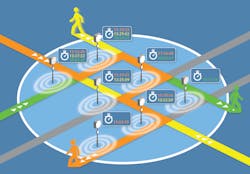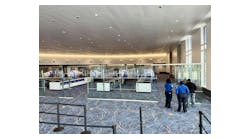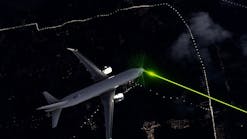Which parking spaces, airport entrances and restrooms do passengers use? How many people show up at airport processes, when do they arrive and how long do they wait in line? How do frequent flyers shop compared to tourists? These questions and more are being answered, based on flow-measurement data from passenger mobile device movements.
How do you ensure that passengers enjoy a first class airport experience, from the moment they enter the car park to boarding the plane and at every stage in between? How do you effectively maximize non-aviation revenue? How do you accurately match staffing resources with passenger demand without violating KPIs?
Handling passenger flow smoothly and efficiently is key to the success of an airport and its image. To understand and improve individual areas of airport operations, it is important to understand that each area influences another and that the traveler's journey is seen as a single process, rather than as a string of isolated events.
Air travel has grown considerably over the last couple of decades, putting pressure on airport infrastructure and processes. However, capacity expansions can be costly, so accurate wait time and flow information is crucial to provide a premium customer experience, improving capacity planning and maximizing revenue.
The basic requirements for happy travelers are easy parking and check-in, speedy security processing, and comfort while waiting in airport terminals. These factors can make or break a passenger's airport experience and strongly influence how much money they spend in the retail areas.
Non-aviation activities have become increasingly important for airports, with several studies revealing that half of airports´ revenue comes from a combination of retail and parking. For example, a 2014 study showed that passengers are willing to spend up to €1,00 per minute in airport concession after completing the security process; however, an extra 10 minutes spent in a security queue reduces passengers' retail spend by on average 30 percent. These findings show the importance of measuring, optimizing and improving passenger flow as an important tool to generate more non-airline revenue for airports.
Measuring passenger flow using mobile device movement data
A recent Expedia survey found that 94 percent of leisure travelers travel with a mobile device, meaning that data collection from mobile devices can accurately provide hard numbers of a significant percentage of travelers.
With sensors that measure the movement of passengers´ mobile devices, airports can generate a cohesive passenger experience picture, including accurately measuring and predicting wait times, while simultaneously providing data about how passengers move and use the airport.
Airports can retrieve both live and historical data about specific patterns, such as entrance and exit usage, walking routes and time spent in various areas, such as security, retail, lounges, rest rooms, gates and more. The patterns can be averaged over a day, a week, a month, as well as a specific time of day, a specific holiday, etc. This enhances an understanding of how disruptions or changes affect standard behavior and enables the airport to add value to existing facilities and new investments to unlock new business opportunities.
Collating the data
Any combination of data can be extracted for measurement, both real-time and historically, to provide the desired output, such as:
- Queue times and occupancy and flow per area, per flight
- Origin/Destination network diagrams
- Auto-profiling passenger behavior from entrance to gate, minute by minute
- Multi-stage passenger show-up profiles
- Forecasting occupancy per shop/restaurant/other area, per flight
- Bypasser/browser/engaged/buyer ratios
- Forecasting shopping time per flight
- Forecasting occupancy and shopping time per flight as a function of check-in/security/gate announcement time/gate allocation.
The statistical combinations can be as generalized or precise as airport management wishes it to be for review and optimization.
Usage
Facilities
Documenting movement patterns is crucial to greater efficiency when planning new construction initiatives and for optimizing the position of signage, processes, retail outlets, services and general layout, to improve the retail tenancy mix and more.
Operation and resource planning
To comply with service-level agreements and evaluate or challenge key performance indicators, it is important to measure and predict queue and flow. This provides airports with resource effectiveness visibility for greater processing efficiency.
As the solution measures passenger flow in real time, it can provide early warning when predefined thresholds are exceeded. This enables airports to proactively initiate countermeasures before the situation escalates, for instance by opening additional processing lines.
By adding third-party data sources, such as flight information and passenger data, airports can forecast passenger volume and show-up profiles generated per weekday, carrier, flight type, etc. This allows airports to simulate the consequences of changing production capacity, to automatically and accurately scale staffing resources with passenger demand, both on the fly and for days, weeks and months to come, without affecting KPIs.
Passenger experience
Travelers hate queues – time spent waiting invariably comes at the top of the list of complaints. This solution enables airports to put lines in perspective, for example with real-time wait times on screens at security and immigration processing. This reduces passenger frustration by creating realistic wait-time expectations.
Retail
Ensuring that passengers experience a quick and easy passage through the first stages of their journey increases positive passenger experience at the airport. The less time passengers spend in airport processes, the more they will enjoy a more stress-free and pleasant travel experience in the concession area, directly increasing non-aviation revenue.
With the extensive knowledge, this system provides about how passengers spend their time in concession areas, retailers can document marketing initiatives and have valuable information that helps improve and optimize services, such as resource allocation, product placement and variety as well as performance benchmarking.
How it works
The sensors detect mobiles devices, such as smartphones and tablets. By identifying the devices as they pass multiple sensors, specific and accurate statistical information, such as travel times, dwell times and movement patterns become available. The sensors are independent of light, work 24/7, require no maintenance and do not interfere with existing Wi-Fi networks.
Both real-time and historical data are presented in a web-based user interface with a series of dashboards with interactive widgets, KPI graphs, Sankey diagrams and more. Data can be extracted through various output facilities, including an open API-interface, allowing for easy and rapid integration into existing management systems.
Sensors versus iBeacons
In order for iBeacons to work as a flow measurement tool, they require that passengers download a mobile app. As mobile device-detecting sensors automatically detect mobile devices with Bluetooth or Wi-Fi enabled, without traveler interaction, the penetration rate is significantly higher (40 percent) than with iBeacons (1 percent).
Christian Bugislaus Carstens is the Marketing Manager for Veovo, producers of the sensor agnostic Passenger Predictability solution. From pedestrian and vehicular queue and flow management, to advanced capacity forecasting, Passenger Predictability provides decision-makers in airports, road traffic, amusement parks, train stations and ski resorts with visibility and other necessary tools to optimize staffing resources and improve revenue, while maintaining a high level of customer service.





